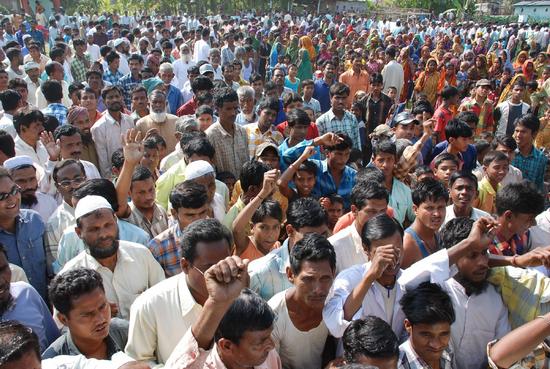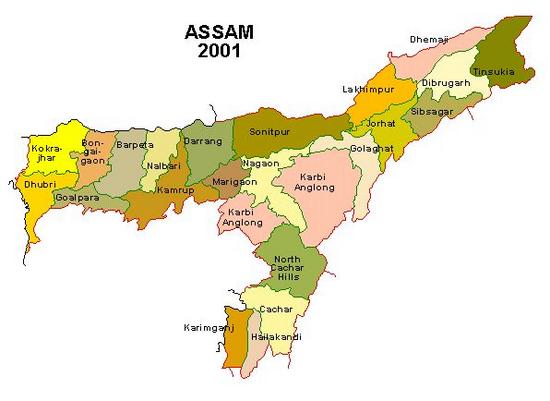By M. Burhanuddin Qasmi
The Census 2011 has begun nationwide on 1st April 2010. Though the Schedules for Census of India 2011 and National Population Register have no columns to enrol one’s language or religion this time, yet it had fuelled past differences of Assamese and Bengalis in Assam. Following is an historic account of this language dispute in Assam, a north-eastern state of India.
The six year long Assam Movement between 1979 and 1985 by All Assam Students Union (AASU) was initially against all ‘outsiders’. Slogans like, “Assam is for the Assamese, “Drive out Indian dogs from Assam” were dominantly inscribed in public places in parts of upper and central Assam. The direction of the agitation was, later, diverted against linguistic and religious minorities – both Bengali Hindus and Muslims and then gradually poor Bengali Muslims become an only easy target.

On February 18th, 1983 Bengali-speaking Muslims alone had to pay the cost of ‘saving democracy’ during infamous Nellie massacre. Both the State and Central governments but miserably failed to protect around 2000 innocent Muslims from extremist butchers at Nellie in Nagoan district of Assam who dared to come out for vote against AASU’s diktat. Even after 27 years a proper enquiry has not been constituted into the pogrom, let alone compensation to the victims or to bring the culprits to justice.
So-called Identity Crises of Indigenous People
The entire propaganda machinery for the Assam Agitation was based on two hypotheses – one majority Muslims are coming from across the open borders of Bangladesh and silently settling in Assam and two because of the unabated infiltration of huge number of Bengalese – both Hindu refugees and Muslims settlers from Bangladesh, the ‘indigenous’ Assamese were being linguistically reduced to a minority and losing their socio-cultural identity in their own land.
The two propositions are totally baseless and falsely propagated to fuel violent separatist and militant movements such as the – United Liberation Front of Assam (ULFA) and instigate a political party – Assam Gana Parishad (AGP) by the AASU leadership 30 years ago. We should shortly analyse the second proposition only in this column that the Bengalis of Assam are not indigenous people of the state and their growing number is endangering Assamese language and culture.
The question of Assamese speaking – the so-called indigenous people becoming a minority in Assam does not arise in the first place because the Assamese speaking people, as a race were never a majority in Assam at any point of time in the history of Assam. As a matter of fact Assam, being a natural place of abode of different linguistic, ethnic, cultural and religious groups of people, has always been a composite state since its inception. Assam is very much like a miniature India, where different races of people lived together and maintained their own identities.
Geneses of Assamese Language
Going by the pre-colonial history, part of present Assam was under Mughal rule through nawabs of Bengal and by their instructions the peasantry from Bengal migrated from East to West Bengal to settle on both sides of the river Brahmaputra for fishing, cultivation and as a way of fighting regular floods that ravaged the area they were then inhabiting. The areas where immigrant Bengali Muslims live for centuries is now known as lower Assam.
The British annexed the remaining parts of Assam (then Ahom) – present upper and parts of central Assam in 1826 and brought it under the provincial administration of Bengal. They also brought English knowing educated Bengalese, skilled farmers and labourers particularly Muslim for assisting in administration, cultivation and construction of public infrastructure which again resulted in large scale migration from the densely populated East Bengal to Brahmaputra valley.
Bengali was the language of the courts and Government schools of Assam in 1837. As per pre-independent census in 1931 the Assamese speaking people constituted only 34 percent of the state population.
In 1951 their number shot up to 64 percent of state population and that is only because of recording of Assamese as the mother tongue in the census by the Bengali speaking Muslims of the Brahmaputra valley.
It is notable that during the period of 20 years from 1951 to 1971, the percentage of growth of Assamese speaking people rose to 80 percent of the state population. An obvious question arises, then where the Assamese had migrated from? The only logical answer is that the Bengalese, especially Muslims, who migrated from lower to upper valleys of the Brahmaputra River till 1971 have largely contributed to the Assamese language and culture and they recorded Assamese as their mother tongue in the census.
But factually the Assamese speaking people do not constitute a majority race in Assam even today. Thus, despite the fact that Assamese language is not a majority language in the state, there is preponderance of the Assamese language and culture with voluntary concurrence and cooperation of Bengali Muslims alone.
Assamese language is a newly evolved offshoot of rich Bangla itself with the minor changes in the script and pronunciation and keeping intact the original Bangla vocabulary.
Bengalese residing in the lower and central regions of Assam in districts like – Dhubri, Kokrajhar, Bongaigaon, Goalpara, Barpeta, Nalbari, Kamrup, Darrang, Udalguri, Sonitpur, Lakhimpur, Dhemaji, Morigaon and Nagaon have converted their official mother tongue to Assamese, thus making the language spoken by the majority in one of the states of India after independence only.
Assamese language became an official language of the state through the Assam Official Language Act, in 1960 only. (Published in the Assam Gazette, Extraordinary, dated the 19th December, 1960)
Bangla Language Movement of Assam
The Bengalese of Barak Valley – both Hindus and Muslims set off a language movement (Second Bangla Bhasha Andolan) demanding due recognition of Assam’s former official Bangla language and their mother tongue following the Assam Legislative Assembly’s introduction of a bill to make Assamese the only official language of the state in early 1960.
The movement reached its climax in 1961 when the Assam Government, under the then chief minister Bimala Prasad Chaliha, issued a circular to make Assamese mandatory, in all parts of Assam to which Bengalese of Barak Valley strongly objected.
On 19th May, 1961, Assam Police opened fire on unarmed protesters at Silchar Railway Station in Cachar district where 11 youth were killed and many more wounded. Coming under intense pressure following the bloodbath in Silchar and ensuing popular revolt, the Government of Assam withdrew the circular. And later through a separate legislation Bengali was given an official status in the three districts – Cachar, Karimganj and Hailakandi of Barak Valley.
The issue of Bangla language came to the forefront once again when Gauhati University sought to introduce Assamese as the only medium of instruction at University level. This led to another mass movement at Barak Valley which saw similar repression and killing. Two youths in Karimganj were killed by police on 21 July 1986, many suffered jail confinement while many more were injured and rendered incapacitated.
An Eye-opener for the Cultural Chauvinist
Going by the present demographic condition in Assam, out of total 27 districts of the state only six districts of upper Assam – Golaghat, Lakhimpur, Jorhat, Sibsagar, Dibrugarh and Tinsukia can be counted as culturally Assamese populous region with a special note, however, that the tea-tribe people who have their own Hindi or Bhojpuri language and culture live in these areas too.
In at least nine districts – Cachar, Karimganj, Hailakandi, Dhubri, Bongaigaon, Goalpara, Barpeta, Morigaon and Nagaon Bengalis form the majority. Four more – Karbi Anglong, N.C. Hills, Kokrajhar and Baksa have different tribal cultures and languages of their own. The remaining eight districts – Nalbari, Kamrup city, Kamrup rural, Darrang, Sonitpur, Dhemaji, Udalguri and Chirag have mixed population of Assamese, Bengalese, tribals and tea labourers.

With the aforementioned details, the obvious conclusion of this linguistic and cultural debate in Assam should be that the Bengalis in Assam are losing their age-old and rich linguistic and cultural grip in the state to newly evolved Assamese language and culture with the voluntary conversion of some Bengalis living in lower and central parts of the state, and not the visa versa at all.
Nonetheless, because of the undue stress on the ‘identity crisis’ of Assamese by some politically astray and chauvinistic youth, the voluntary and natural process of different tribals and Bengalese assimilation into Assamese language and culture in post-independence India has got a big jolt. It rather became counter productive.
Different linguistic, ethnic and cultural groups living in the state are fighting to save their own identities. This not only has disturbed the natural progress and growth of the state along with its language and culture but also endangered the state’s own unity, sovereignty and multicultural fabric.
The north-eastern states of Nagaland, Arunachal Pradesh, Meghalaya and Mizoram have fought and got separate statehood primarily on the issue of cultural identity. On 20 February 1987 Mizoram got the formal recognition as the last independent state that was broken away from Assam by the then Prime Minister Rajiv Gandhi.
Thanks to the lingual and cultural chauvinism; in the name of saving the ‘indigenous identity’ it is helping the mushrooming of new independent state seekers. At least three more regions – Bodo Autonomous Council, North Cachar Autonomous Council and Karbi Anglong are now following militant ways for their independent statehood to break away from Assam.
I am afraid, if things continue like this, Bengalis of the Barak Valley may seek their separate state to save their culture and language. Then Bengalis living in the lower Assam may follow their democratic right of living by using their own language and culture rather than becoming unwanted members of an Assamese culture? And then present Assam will be reduced into Ahom once again!
M. Burhanuddin Qasmi is editor of Eastern Crescent magazine and director of Mumbai based Markazul Ma’arif Education & Research Centre. He can be contacted at [email protected]



